![]()
Aroids and other genera in the Collection
Take the Tour Now?
Orchids
The
Exotic Rainforest
Plants in
the Exotic Rainforest Collection
Images on this website are copyright protected. Contact us before attempting to reuse.
In depth information, how to grow Philodendron species, Click this Link
Within our collection we have many species of Philodendron. If you are seeking other photos, click this link
Philodendron
bipennifolium
Schott ex Endl
Often
incorrectly known as Philodendron
panduriforme

Synonym: Philodendron wayombense
incorrectly sold as Philodendron panduriforme
Horse Head Philodendron, Fiddle Leaf Philodendron, Panda Plant, Splash Gordon Plant
Seeking information on Philodendron panduriforme?
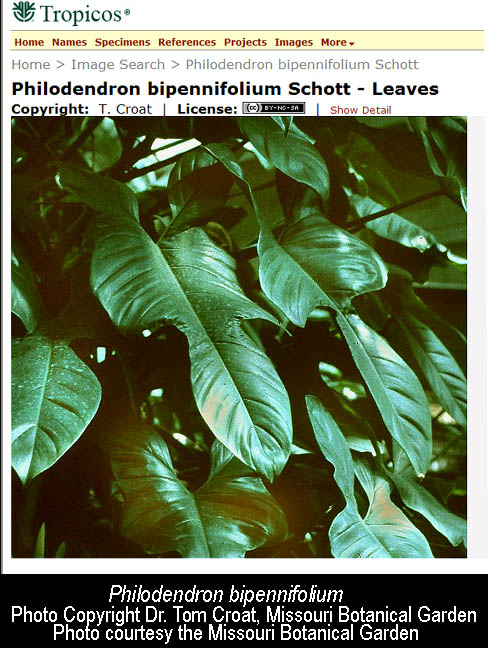 Sometimes
confusing, Philodendron bipennifolium is an aroid
commonly known only by the shape of the juvenile leaves shown in
the inset photo to the right. Once it begins to mature, many
would never recognize the species as the same plant as the
adult! These changes in leaf shape on a single plant are
known as to be heterophyllus.
Sometimes
confusing, Philodendron bipennifolium is an aroid
commonly known only by the shape of the juvenile leaves shown in
the inset photo to the right. Once it begins to mature, many
would never recognize the species as the same plant as the
adult! These changes in leaf shape on a single plant are
known as to be heterophyllus.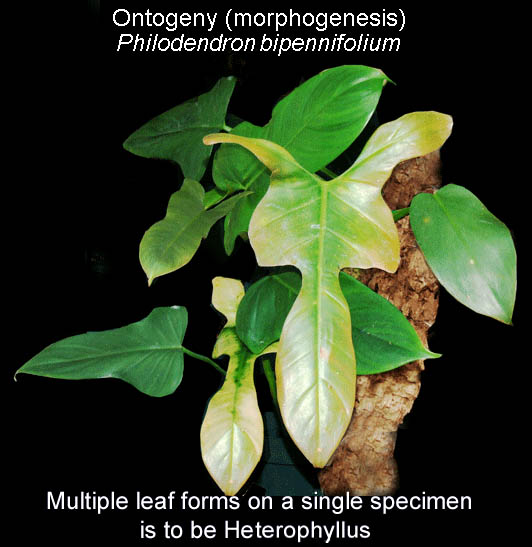 Many assume
Philodendron panduriforme is synonym for Philodendron
bipennifolium. Where that information
originated
cannot be verified, but
the two species are not synonymous and
that belief is not supported by any botanical database. Others
believe Philodendron panduriforme looks just like
Philodendron
bipennifolium. They do not. One very good noted book
by author Deni Bown indicates the two species are one and the
same, however, according to Dr. Croat and other aroid experts
they are very different and have no relationship other than they
are both Philodendron species.
Many assume
Philodendron panduriforme is synonym for Philodendron
bipennifolium. Where that information
originated
cannot be verified, but
the two species are not synonymous and
that belief is not supported by any botanical database. Others
believe Philodendron panduriforme looks just like
Philodendron
bipennifolium. They do not. One very good noted book
by author Deni Bown indicates the two species are one and the
same, however, according to Dr. Croat and other aroid experts
they are very different and have no relationship other than they
are both Philodendron species.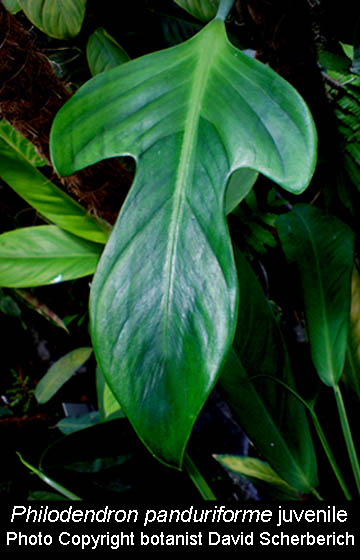 In
an exchange of email with Dr. Croat , he wrote,
"Philodendron panduriforme is a distinct species which is merely
3-lobed. See Aroideana volume 9, I believe where I published
the Araceae
of
Venezuela. Philodendron bipennifolium does not resemble P.
panduriforme at all and is surely unrelated. The photo you
attached is P. bipennifolium."
In
an exchange of email with Dr. Croat , he wrote,
"Philodendron panduriforme is a distinct species which is merely
3-lobed. See Aroideana volume 9, I believe where I published
the Araceae
of
Venezuela. Philodendron bipennifolium does not resemble P.
panduriforme at all and is surely unrelated. The photo you
attached is P. bipennifolium."
 The photo on the right of
an adult specimen of Philodendron panduriforme is from
volume 9 of Aroideana (published by the International Aroid
Society). It was scanned and used with Croat's permission. The
photo on the left is a young specimen of P. panduriforme
from our own collection. As is obvious, the two photos bear
bear little resemblance to the photos of Philodendron
bipennifolium shown above. As you can see, Philodendron
panduriforme also morphs as it grows. However, in the
juvenile state, Philodendron panduriforme does very
slightly resemble Philodendron bipennifolium. After
reviewing a photo of a juvenile P. panduriforme, Dr.
Croat responded, "I
can see why Deni Bown thought this is the same as P.
bipennifolium. The problem is this species (P. panduriforme) is
usually more deeply 3-lobed."
The photo on the right of
an adult specimen of Philodendron panduriforme is from
volume 9 of Aroideana (published by the International Aroid
Society). It was scanned and used with Croat's permission. The
photo on the left is a young specimen of P. panduriforme
from our own collection. As is obvious, the two photos bear
bear little resemblance to the photos of Philodendron
bipennifolium shown above. As you can see, Philodendron
panduriforme also morphs as it grows. However, in the
juvenile state, Philodendron panduriforme does very
slightly resemble Philodendron bipennifolium. After
reviewing a photo of a juvenile P. panduriforme, Dr.
Croat responded, "I
can see why Deni Bown thought this is the same as P.
bipennifolium. The problem is this species (P. panduriforme) is
usually more deeply 3-lobed."
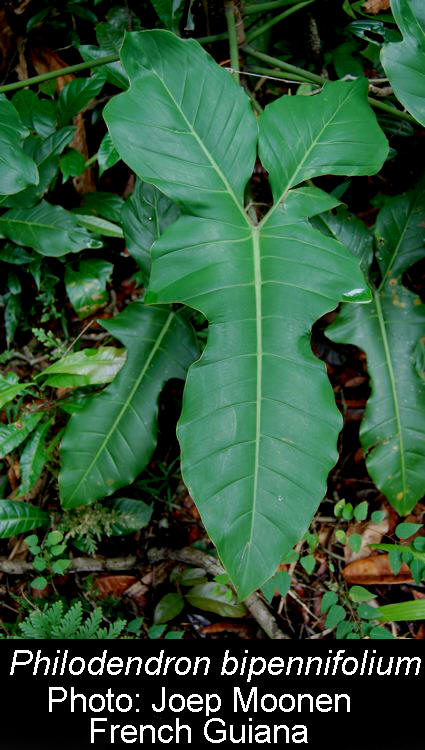 resemblance
to the juvenile plants nearing adulthood, but it is still very
different from a young juvenile. Aroid expert Julius Boos in
West Palm Beach, FL sent a description of Philodendron
panduriforme which matches Dr. Croat's photo and the photo
of my juvenile specimen:
"They
(P. bipennifolium and P. panduriforme)
look nothing alike, and could never be confused as the same
species. Philodendron panduriforme has a shallow lobed blade
with three shallow lobes, rounded tips to the lobes, and no more
then scallops that do not go deep or anywhere near the main
veins. In the photo of P. bipennifolium, the divisions in the
blade seem deeply cut with pointed sections which 'cut' near or
to the main veins."
resemblance
to the juvenile plants nearing adulthood, but it is still very
different from a young juvenile. Aroid expert Julius Boos in
West Palm Beach, FL sent a description of Philodendron
panduriforme which matches Dr. Croat's photo and the photo
of my juvenile specimen:
"They
(P. bipennifolium and P. panduriforme)
look nothing alike, and could never be confused as the same
species. Philodendron panduriforme has a shallow lobed blade
with three shallow lobes, rounded tips to the lobes, and no more
then scallops that do not go deep or anywhere near the main
veins. In the photo of P. bipennifolium, the divisions in the
blade seem deeply cut with pointed sections which 'cut' near or
to the main veins."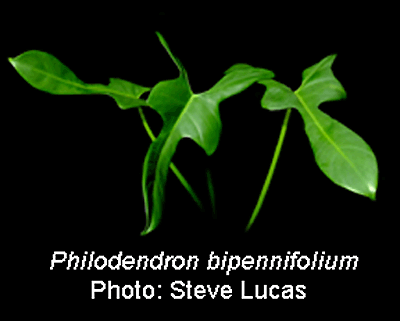 Also confusing to
plant collectors, morphogenesis and natural variation are common
within aroid species. The following link uses photos
to explain in
non-technical language natural variation and morphogenesis.
Click here.
Also confusing to
plant collectors, morphogenesis and natural variation are common
within aroid species. The following link uses photos
to explain in
non-technical language natural variation and morphogenesis.
Click here.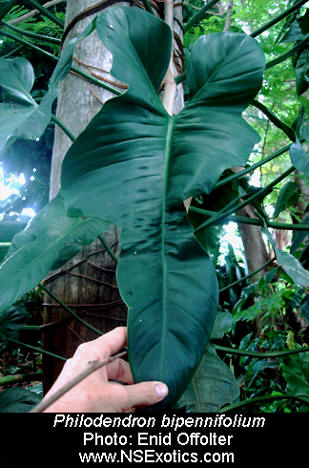 leaves on this page, all of
which are growing on a single vine in our collection, you can
see Philodendron bipennifolium
goes through the juvenile
stages of morphogenesis It changes as ot grows and the rounded
upper lobes become pointed. The adult form of Philodendron
bipennifolium normally has two upwardly pointing lobes which
narrow sharply.
Then the blade again widens to form a leaf that appears to have
a "fat" mid-section with a pointed lower blade.
leaves on this page, all of
which are growing on a single vine in our collection, you can
see Philodendron bipennifolium
goes through the juvenile
stages of morphogenesis It changes as ot grows and the rounded
upper lobes become pointed. The adult form of Philodendron
bipennifolium normally has two upwardly pointing lobes which
narrow sharply.
Then the blade again widens to form a leaf that appears to have
a "fat" mid-section with a pointed lower blade.
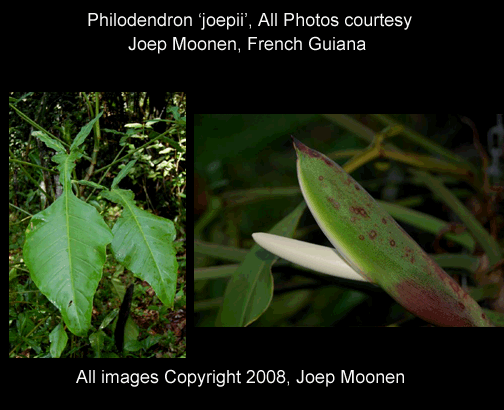
The leaves of our immature specimens tend to be approximately 25cm (10 inches) in length but grow much larger once they mature.
Incorrect information found on the internet suggests Philodendron bipennifolium is a hybrid, but since the species was described to science in1855 that is nothing more than an internet plant myth!
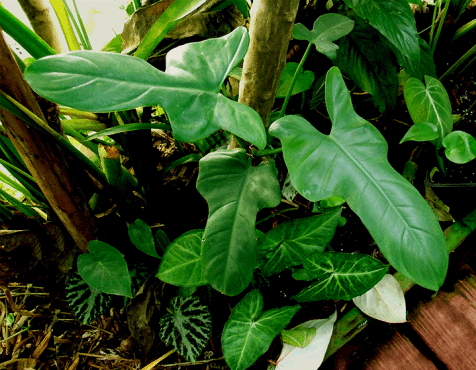
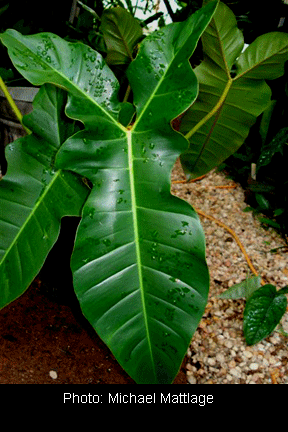
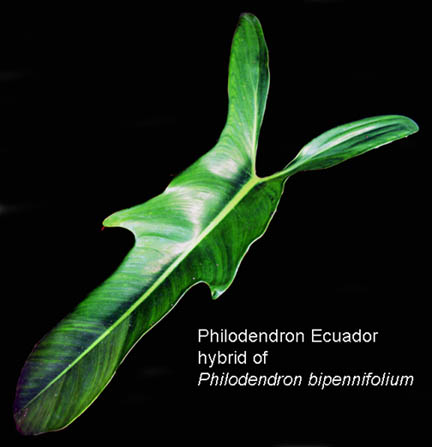
or
Brian's Botanicals http://www.briansbotanicals.net/

Join the International Aroid Society: http://www.exoticrainforest.com/Join%20IAS.html